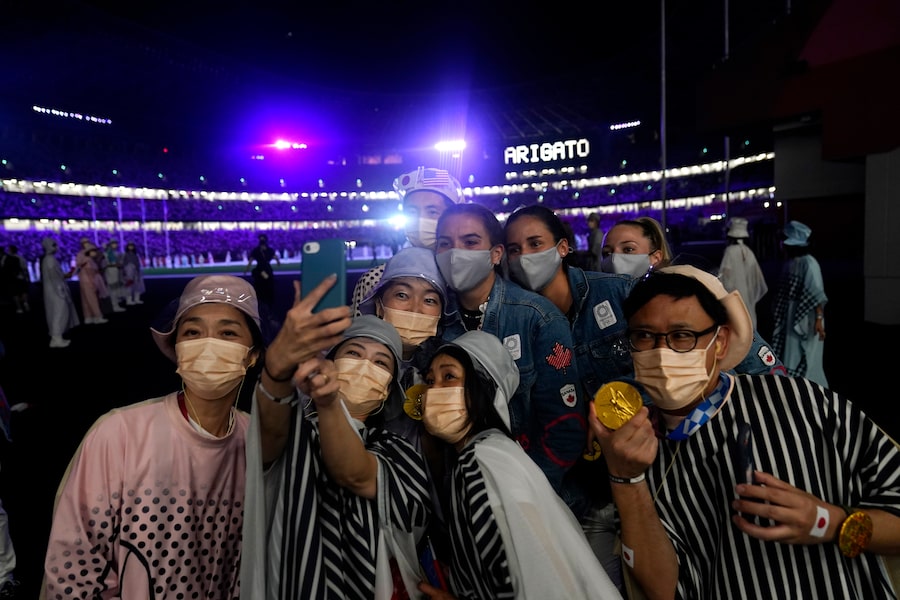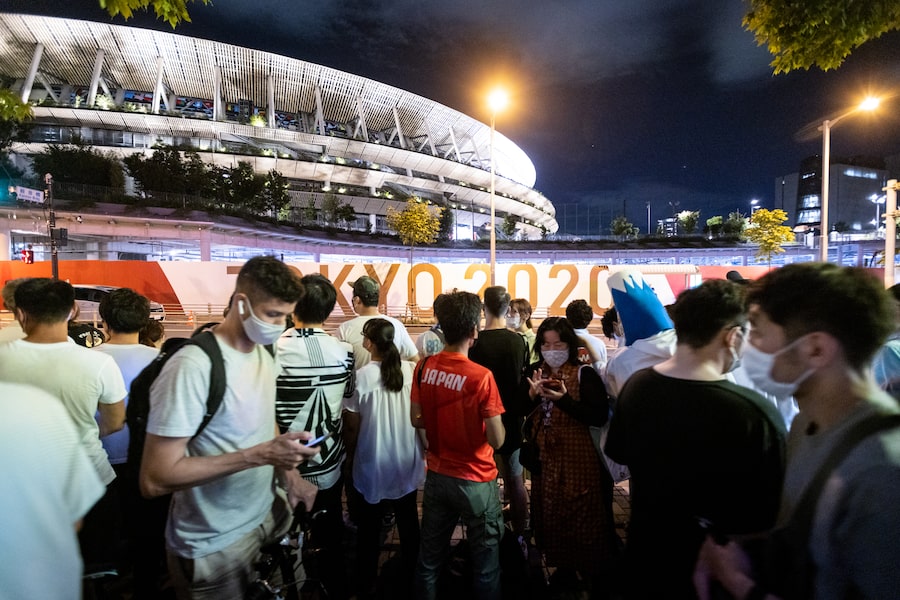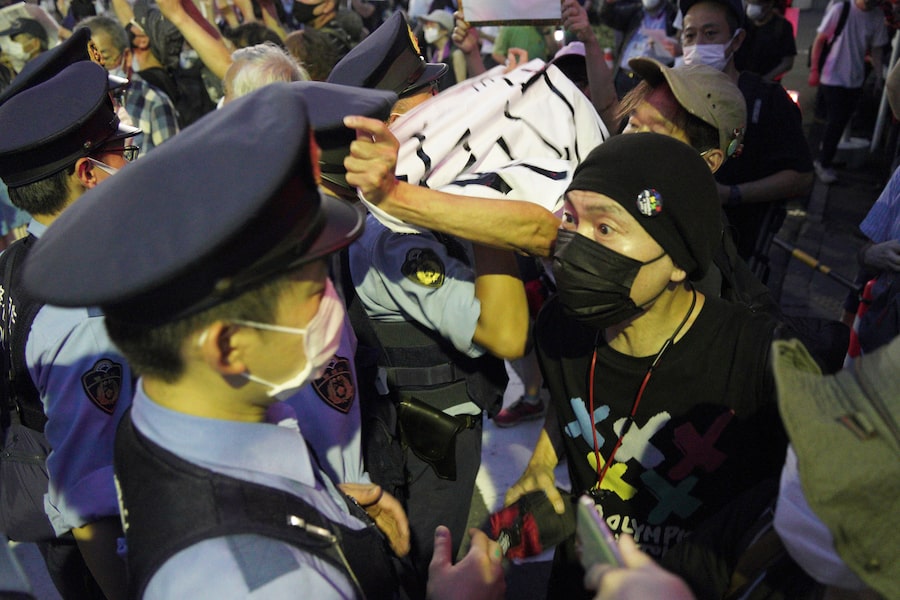Canada's athletes walk across the field during the closing ceremony of the Tokyo 2020 Olympic Games, on August 8, 2021 at the Olympic Stadium in Tokyo.OLI SCARFF/AFP/Getty Images
On a night with Japanese dance and music, a complicated Tokyo Olympics took its final bow.
An understated closing ceremony on Sunday night wrapped up an Olympics that was delayed by a year and disappointed much of the Japanese public, yet managed to remain outbreak-free inside its fences and provide some memorable sport performances.
The stands inside Olympic Stadium were empty but darkened. Millions watched these Olympics around the world, yet few were inside to witness it live in person. It was a Games full of triumphs and resilience, but its lasting images will be of athletes on podiums in masks.
Approximately 120 Canadian athletes and coaches took part Sunday night. The countries strolled into Olympic Stadium in a lengthy haphazard procession to start the ceremony, with all participants intermingling. The Canadians could be clearly spotted by their audacious graffiti-splashed jean jackets, an outfit that sparked widespread sneers from fashion critics when their extensive Hudson’s Bay Olympic team clothing was unveiled.
Freshly minted Olympic decathlon champion Damian Warner carried Canada’s flag, and called it the honour of his life. The 31-year-old three-time Olympian scored 9,018 points on his way to a gold medal in Tokyo, setting an Olympic record in one of the oldest events at the Games, and arguably its most challenging.
Warner’s story of resilience in training during the pandemic was whole-hearted. With sports facilities closed, his London, Ont., community rallied to turn an old chilly hockey arena into a makeshift training facility for him, complete with a track and pits so he could practise the 10 events in his combo sport. He did so while many of his competitors around the world trained as usual.
Canada was ripe with great options for the job of flag bearer, such as sprinter Andre De Grasse, who earned three more medals in Tokyo, or the stars of Canada’s gold-medal-winning women’s soccer team.
Most of Canada’s delegation – which had been 840 people strong throughout the Games – already left Tokyo, because COVID-19 protocols stated that every participant depart the city within 48 hours of finishing their competition. Canada celebrates 24 medals – a record for the country at a non-boycotted Summer Olympics. The Canadian Olympic Committee says its delegation did not have a single positive COVID-19 test in Tokyo.
Canada wraps up the Tokyo Olympics with a total of 24 medals, the most in a Summer Games without a boycott. Catch up on the moments that saw Canada win 7 gold, six silver and 11 bronze medals from the pool to the running track.
The Globe and Mail
Four years ago, Kelsey Mitchell didn’t own a bike. Now, she’s a Tokyo Olympic cycling champion
It was the end of a different Games, to be sure. It was imperfect, but the strict COVID-19 protocols that stripped the Games of much of their usual off-field fun seemed to work, at least inside the walls and fences. This Olympics soldiered on, even when so many said it shouldn’t.
The crowd that gathered outside the stadium Sunday night summed up the mixed sentiment from the people of Tokyo. Police stood by to keep an eye on a small group of anti-Games protesters. Then there were the citizens who wanted to get close to it, even though they had never been welcomed inside – standing outside the stadium fences and lining up to snap photos with the Olympic rings.
Tokyo Olympics will forever be known as the first COVID Olympics
The ceremony included Japanese musicians and dancers, lighting effects and fireworks, but little in the way of the over-the-top rock concert vibe that has become so typical of modern day Olympic ceremonies. The most moving elements of the show were recorded video pieces featuring traditional Japanese dance from around other parts of the country.
What did Japan get out of the Games? The country played host with kindness and grace, so eager to offer a kind hello, to usher a journalist toward a shady spot in relief of the crushing Tokyo heat. Yet it was a party the Japanese couldn’t even attend. The country’s organizing committee took care of the unglamorous work: the bus driving and airport arrivals, the temperature taking, sanitizing and the processing of hundreds of thousands of COVID-19 saliva tests.
There was a team of people and small cars that set up the hurdles on the track at Olympic stadium in rapid, mesmerizing fashion, doing their job to perfection. And a crew that set the coloured mats for the judo events, like perfect puzzle pieces, at the Nippon Budokan.
They played glossy videos in venues that fans never got to see. Their mascots walked around with no one to excite. Tourists did not come to watch, to spend, or party in the world-class city. Athletes will remember it as the Olympics where they wore masks and left their families at home.

The view of the starting line ahead of the men’s 100-m in a completely empty Tokyo Olympic Stadium.Melissa Tait/The Globe and Mail
As Tokyo passed the baton to the next Summer Olympic host – Paris in 2024 – video showed signs of hope for a return to normalcy. Live shots from France showed people gathered by the Eiffel Tower, dancing, celebrating, and many not wearing masks. Fighter jets punctuated the occasion with a fly-by.
Tokyo pulled it off, but with no pizzazz. Its closing ceremony captured the stark difference between what was Tokyo was and Paris hopes to be.






 Rachel Brady
Rachel Brady